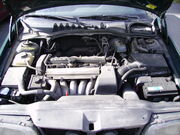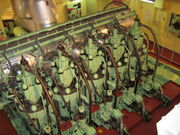
The Volvo B5252S is an example of a straight-5 engine.
The straight-five engine or inline-five engine is an internal combustion engine with five cylinders aligned in one row or plane, sharing a single engine block and crankcase. This configuration is a compromise between the smaller inline-four engine and the larger straight-6.
Henry Ford had a inline-five engine developed in the late 1930's to early 1940's for a compact economy car design, which never saw production due to lack of demand for small cars in the United States.[1] Consequently, a straight-five engine did not see production for passenger cars until Mercedes-Benz introduced the OM617 diesel in 1974. The first production petrol straight-five was the 2.1 R5 introduced by Volkswagen Group in the Audi 100 towards the end of the 1970's, developments of which powered the Audi Quattro rally racer.[2] Since Volvo introduced their Volvo 850 in 1992, much of their lineup has switched to straight-five power, with their engines also seeing use in Ford's Focus ST and RS models. Honda used straight-fives in the Vigor and Acura TL.
In the late 1990's, Rover Group developed an in-house straight-five diesel engine, the Td5, for the Discovery and Defender. Volkswagen has used straight-five engines in their Eurovan, and have recently developed a different straight-five engine which is used in the Jetta and Rabbit in North America. Fiat also makes use of straight-fives (both petrol and diesel) in larger Fiat, Alfa Romeo and Lancia models. General Motors has used Atlas-based straight-fives in their GMT 355 mid-size truck family since 2004.
Characteristics[]

The MAN B&W 5S50MC five-cylinder two-stroke diesel engine. This particular engine is found aboard a 29000 tonne chemical carrier.
The five-cylinder engine's advantage over a comparable four-cylinder engine is best understood by considering power strokes and their frequency. A four-stroke cycle engine fires its cylinders once every 720 degrees — the crankshaft makes two complete rotations. If we assume an even firing engine, we can divide 720 degrees by the number of cylinders to determine how often a power stroke occurs. For a four-cylinder engine, 720° ÷ 4 = 180° so there is a power stroke every 180 degrees, which is two power strokes per revolution of the crankshaft. A V8 engine gets a power stroke every 90 degrees: 720° ÷ 8 = 90°, which is four power stokes for each revolution of the crankshaft.
A given power stroke can last no more than 180 degrees of crankshaft rotation, so the power strokes of a four-cylinder engine are sequential, with no overlap. At the end of one cylinder's power stroke another cylinder fires.
In a one-, two-, or three-cylinder engine there are times when no power stroke is occurring. In a three-cylinder engine a power stroke occurs every 240 degrees (720° ÷ 3 = 240°). Since a power stroke cannot last longer than 180 degrees, this means that a three-cylinder engine has 60 degrees of "silence" when no power stroke takes place.
A five-cylinder engine gets a power stroke every 144 degrees (720° ÷ 5 = 144°). Since each power stroke lasts 180 degrees, this means that a power stroke is always in effect. Because of uneven levels of torque during the expansion strokes divided among the five cylinders, there is increased secondary-order vibrations. At higher engine speeds, there is an uneven third-order vibration from the crankshaft which occurs every 144 degrees. Because the power strokes have some overlap, a five-cylinder engine may run more smoothly than a non-overlapping four-cylinder engine, but only at limited mid-range speeds where second and third-order vibrations are lower.
Every cylinder added beyond five increases the overlap of firing strokes and makes for less primary order vibration. An inline-six gets a power stroke every 120 degrees. So there is more overlap (180° - 120° = 60°) than in a five-cylinder engine (180° - 144° = 36°). However, this increase in smoothness of a six-cylinder engine over a five-cylinder engine is not as pronounced as that of a five-cylinder engine over a four-cylinder engine. The inline-five loses less power to friction as compared to an inline-six. It also uses fewer parts, and it is physically shorter, so it requires less room in the engine bay, allowing for transverse mounting.
A five-cylinder engine is longer and more expensive to manufacture than a comparable four-cylinder engine, but some manufacturers feel these costs are outweighed by its greater capacity in a smaller space than a six-cylinder.
From the standpoint of driving experience, five-cylinder engines are noted for combining the best aspects of four- and six-cylinder engines. They generate more power and torque than four-cylinder engines, while maintaining the fuel economy and "pep" of smaller six-cylinder engines. Five-cylinder turbos have been used on more than one occasion in sport and racing applications for their balance of performance qualities. The Volvo S60 R has a 2.5 litre turbocharged inline five-cylinder engine which is capable of generating 300 brake horsepower (224 kW) and 295 lbf·ft (400 N·m) of torque across a large amount of its rpm ranges. The new Ford Focus RS performance car uses the same Volvo 5-cylinder engine, developed (by Ford) to very similar power levels, and is one of the most powerful FWD production cars ever created.
A disadvantage of a straight-five over a straight-six engine is that a straight-five engine is not inherently balanced. A straight-five design has free moments (vibrations) of the first and second order, while a straight-six has zero free moments. This means that no additional balance shafts are needed in a straight-six. By comparison an inline-four engine has no free moments of the first or second order, but it does have a large free force of the second order which contributes to the vibration found in unbalanced straight-four designs.[3]
The use of straight-five petrol engines in mass production cars only became truly viable with the advent of reliable fuel injection. A five-cylinder engine using a carburetor fuel system has an unavoidable problem in that the length of the inlet manifold between the carburetor varies too greatly between cylinders at the ends of the engine and those nearer the carburetor for reliable and consistent fuel delivery. Using multiple carburetors (two or three) always results in one carburetor feeding more cylinders than the other, which also produces running and tuning problems. In theory individual carburetors could be used for each cylinder, but this approach is expensive and still brings with it the attendant difficulties in balancing the multiple carbs. Multi-point fuel injection circumvents all the above problems by feeding each cylinder individually from a central, single pump. This fuelling issue was never present in diesel engines which used direct injection from the very start, which is why large five-cylinder diesels were commonly seen decades before the type's adoption for automotive use.
Automobile use[]
The smallest production straight-five was found on the 1981 Audi 100, with 1921 cc of displacement.[4] Audi used straight-five engines in many of their cars between 1977 and the early 1990s, and started using them again today along with VW. Mercedes used five-cylinder configuration for their diesels in the 1970s all the way to the 2000s. The GM Atlas L5R 3700 is the largest at 3,654 cc. Currently Volvo Cars uses the straight five-cylinder engine as their mainstay engine in every vehicle in the lineup. All of the inline five engines used by Volvo and Ford are built at the Volvo Skövde engine plant in Skövde, Sweden.
The Audi S-5, 2226 cc, 4v/cyl, was also used on the Italdesign Aztec. It could produce 200 bhp (149 kW/203 PS) at 6,200 rpm.
Motorcycle use[]
The smallest straight-five was found on the Honda racing motorcycle, the 125-cc-class RC149, raced in 1966. The five-cylinder configuration was used because it shared components (and hence simultaneous development) with the two-cylinder engine, 50 cc, RC116.[5]
References[]
- ↑ {{{author}}}, Henry Ford's Weird Old Engines, [[{{{publisher}}}]], August 1960.
- ↑ Graham Robson. Audi Quattro, 12.
- ↑ Robert Bosch GmbH, Bosch Automotive Handbook, 6th edition p. 459-463, Professional Engineering Publishing 2004, ISBN 1-86058-474-8.
- ↑ "Cars++ 1985 Audi 100 1.9 page". Carsplusplus.com. Retrieved on 2011-01-17.
- ↑ "Joep Kortekaas' Honda Race History - 1966". Vf750fd.com. Retrieved on 2011-01-17.
| |||||||||||||||||||||||||||||||||||||||
| This page uses some content from Wikipedia. The original article was at Straight-five engine. The list of authors can be seen in the page history. As with Tractor & Construction Plant Wiki, the text of Wikipedia is available under the Creative Commons by Attribution License and/or GNU Free Documentation License. Please check page history for when the original article was copied to Wikia |